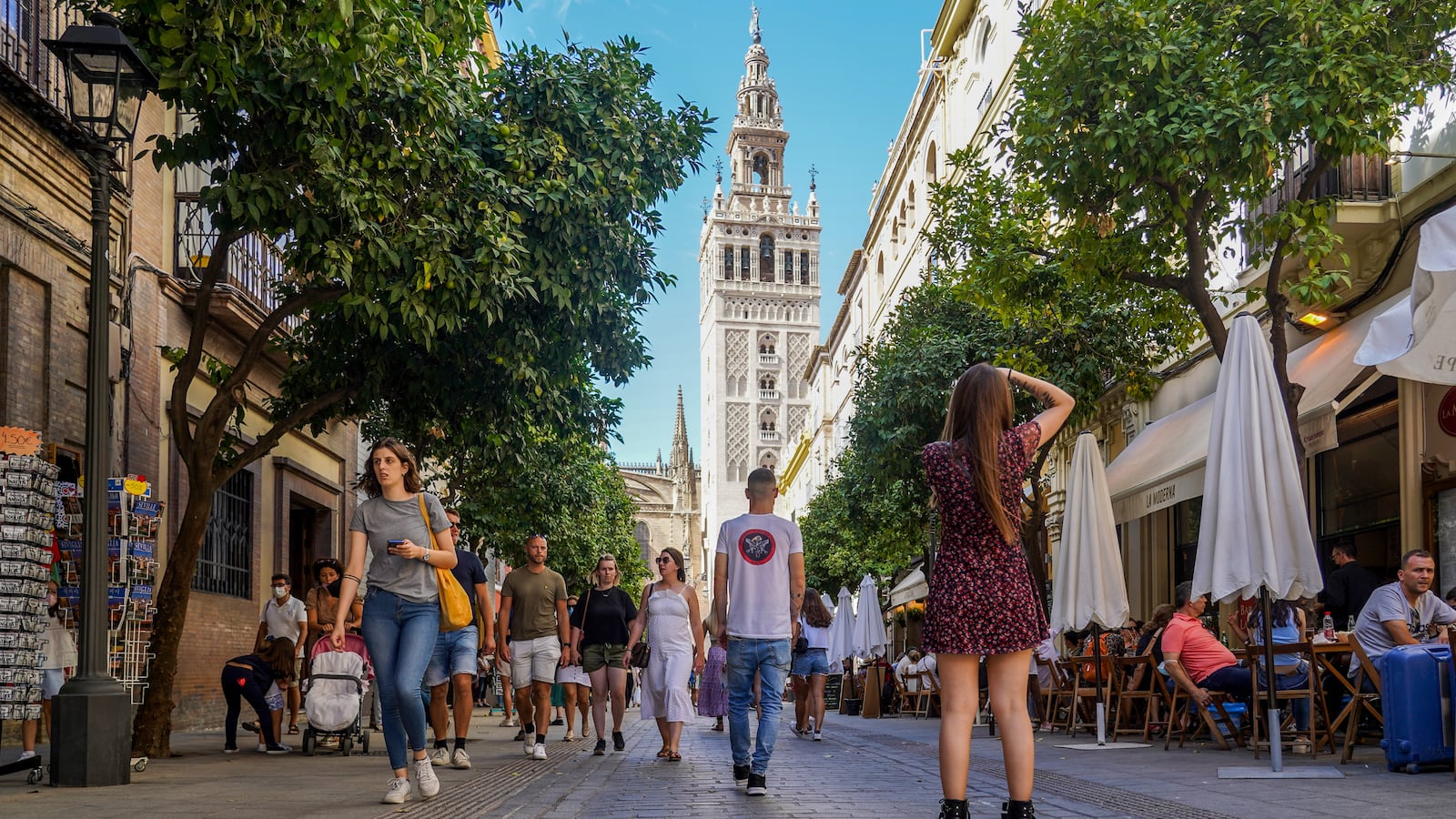Sevilla is storybook Spain. There are plazas perfumed with orange blossoms where abuelos play checkers at dusk. In tile-floor tapas bars, jamones dangle from the rafters while sherry flows straight from the barrel. Across the Guadalquivir, flamenco dancers twirl and stomp to cries of ¡Olé! as the day’s last light sets the Giralda minaret aglow. The old-school Sevilla of Moorish arches and horse-drawn carriages is happily alive and well, but limit yourself to the city’s traditional side, and you’re missing half the fun.
That’s what I discovered on my first trip south after a long, pandemic-imposed break. For months I’d been housebound in Madrid, far from Sevilla’s creature comforts: leisurely river walks, fried anchovies at Blanco Cerrillo, afternoons spent reading in flower-filled courtyards. But I missed exploring Sevilla’s tangle of medieval streets most of all—the thrill of happening upon a little-known museum or obscure local dish.
I had so much pent-up wanderlust that I resolved to skip my old standbys altogether—if they’d survived the pandemic, they surely weren’t going anywhere—and take in the city with new eyes. After all, there was plenty to keep me busy: While other Spanish capitals hibernated through the pandemic, Sevilla had leveled up, adding dozens of new attractions and renovating historical sites. A week of dawn-to-dusk research later, and the results were in: Despite being walloped by the pandemic, Sevilla, against all odds, was roaring back.

A reflecting pool in the Courtyard of the Maidens at Alcazar palace in Seville.
Education Images/Universal Images Group via Getty ImagesA Flurry of Hotel Openings
Sevilla inaugurated more hotels last year than any other city in Spain—roughly 1,000 new rooms spread across 25 new properties. On the luxury end of the spectrum, big-box projects like the five-month-old Radisson and incoming Autograph by Marriott have been getting all the press—which makes Casa de la Moneda, which opened in November, all the more exclusive. Housed in a restored 16th-century mint around the corner from the cathedral, it takes in 10 spacious apartments, three with sundecks and private pools. In the public areas, Macael marble fountains and wrought-iron balconies preserve the building’s stately grandeur, while in the guest rooms, Castilian cane chairs and fringed velvet ottomans keep things homey and unpretentious. The front desk is manned by one lone attendant, and the halls are whisper-quiet; there’s 24-hour assistance via Whatsapp, but staff essentially leave you be—to me, the ultimate luxury. I was glad to have scored a stay when I did, since without a doubt, Casa de La Moneda is about to become a design hotspot with a waitlist.
If Casa de la Moneda is out of reach (for its price, high occupancy, or otherwise), consider Casa Hotel 1800 Sevilla. Brand-new it isn’t—sue me—but the hotel’s seamless fusion of the modern and the antique makes it as relevant as ever. In a Belle Époque palace in the heart of the old town, 1800 serves you a helping of history (original banisters, period furniture, carved gilded headboards) without skimping on the perks you’d expect in a 21st-century five-star such as hydromassage tubs, double-paned glass, and a rooftop bar with jaw-dropping views of the Giralda tower.
Perhaps more practical—and affordable—for short-term visitors is Intur Casa de Indias, the charming 61-room hotel that opened in 2019 beneath Jürgen Mayer’s futuristic wooden towers known affectionately to locals as the Setas (“Mushrooms”). It’s a pity Intur’s opening was overshadowed by the pandemic, since its rooms are so on-trend and inviting—think rounded wicker headboards, deep-soak tubs, and sculptural eggshell-blue nightstands. The rooftop pool and bar, from which you can gaze out over the terracotta roofscape, is a godsent alternative to the mob scene atop the Setas just across the way.

‘Zero-Kilometer’ Cuisine
Sevilla was late to embrace the farm-to-table trend, but it’s making up for lost time with restaurants like Contenedor and Ispal. The first is the kind of neighborhood bistro I wish I lived above—candlelit, buzzy, eclectic, and virtually tourist-free. There are no printed menus here but rather poster-size chalkboards that T-shirt-clad waiters read out to every table. I sprang for the roast wild croaker (the fish, not the frog), cooked until barely opaque and topped with oyster sauce, mustard greens, and crunchy peanuts—a middle finger, it seemed to me, to Spain’s usual minimalist approach to seafood. I was ready to join the resistance.
If I were Sevillano, Contenedor would be my weeknight hangout and Ispal my special-occasion treat. Call it traditional Andalusian cuisine from the future: There was old-school partridge in escabeche, except it was slicked with tangy tamarind pulp; there was Sevilla-style “adobito,” but an oyster stood in for the shark and crackly tempura batter replaced the flour. I was three goblets of Andalusian wine deep when the waiter pointed at the candle and said, bafflingly, “Go on, eat it.” It turned out to be manteca colorá, a local specialty of pimentón-laced lard that’s customarily smeared on toast at breakfast. Ispal needs a gift shop if only to sell its trompe l'oeil lard candles. Rounding out the trippy experience was a custardy torrija (basically Spanish “French” toast), which arrived to the tune of chimes emulating church bells, a tribute to the processions of Holy Week, when the confection is traditionally eaten. Wobbly, sweet, and gooey with sugar syrup, it was the most classic dish of the evening. Certain foods are too holy to be tinkered with.

Women in traditional dresses dance during the “Feria de Abril” (April Fair) festival in Seville.
Cristina Quicler/AFP via Getty ImagesUnsung Attractions
Did you know there was a still-active Mudejar palace in the center of Sevilla owned by the legendary House of Alba—and that poor plebeians like us could tour the grounds? Me neither, until I reported on the noble family’s Madrid abode. Built between the 15th and 16th centuries yet only open to the public since 2016, Palacio de las Dueñas is a fever dream of colorful azulejos, manicured gardens, flamenco memorabilia, and a museum’s-worth of art by the likes of Neri di Bicci and José de Ribera. In January a new room dripping with bullfighting trophies and paintings called Salón de Carteles opened its doors to the public. The estate offers a rare window into the private life of one of Europe’s most fabled noble families. Spanish poet Antonio Machado, I learned on the tour, spent his youth here. “My childhood memories are of a courtyard in Sevilla and a bright garden where the lemon tree ripens,” he wrote of the palace in 1912.
WIth achy feet and audioguide fatigue, I was ready to unwind. So I booked a session at the Sevilla outpost of Aire Ancient Baths, a thermal spa with a steam room, sauna, and flickering candles designed to evoke Moorish hammams of yore. The duduk music and coed pools were an early sign that historical accuracy wasn’t a priority, but it’s hard to keep one’s eyebrow raised about cultural appropriation with one’s face is smushed into a horseshoe pillow. Aire has spas as far away as Copenhagen and Chicago, but those most certainly don’t boast a rooftop whirlpool bath from which you can take in the wonders of actual Moorish architecture.

Views of the Setas de la Encarnacion, designed by the Berlin architect Jurgen Mayer.
Maria Jose Lopez/Europa Press via Getty ImagesCeramics With a Story
Most of the patterned clay plates, bowls, jugs, and tiles sold in Sevilla’s dime-a-dozen souvenir shops are cheaply manufactured abroad. That’s why Populart is such a diamond in the rough: This quaint boutique in the Santa Cruz neighborhood preserves antique Spanish ceramics ranging from 16th-century azulejos to baptismal fonts to lebrillos, colorful and strikingly voluminous basins used historically at communal pig slaughters. There’s a strong showing of vintage crockery from La Cartuja, the famed Sevilla factory. Populart ships worldwide, minimizing schlepping and accidental breakage.

The royal Alcazar palace of Seville, with its green labyrinths and rustling secrets.
Andia/Universal Images Group via Getty Images
